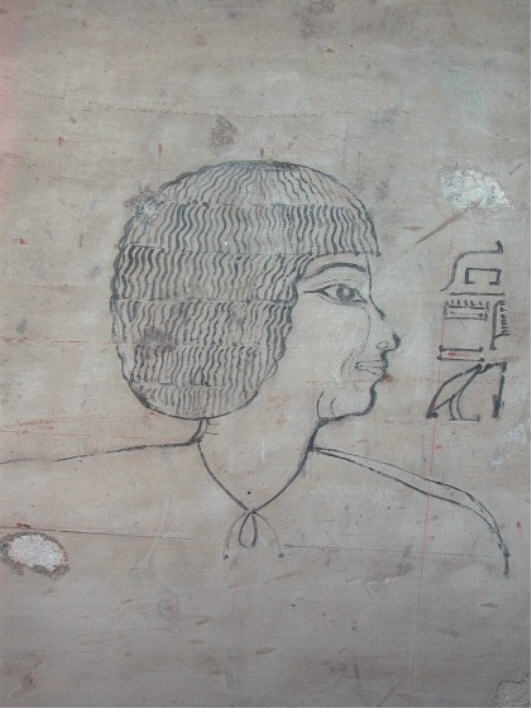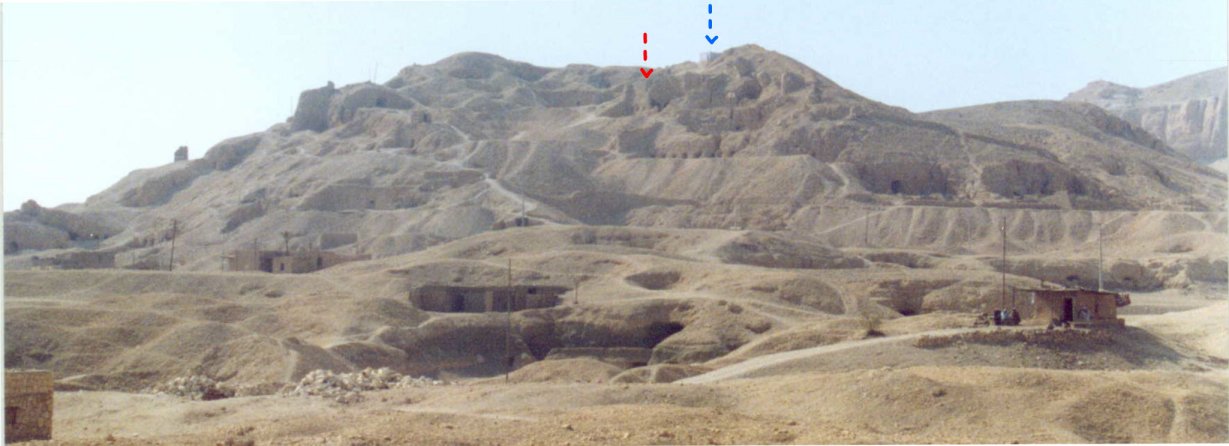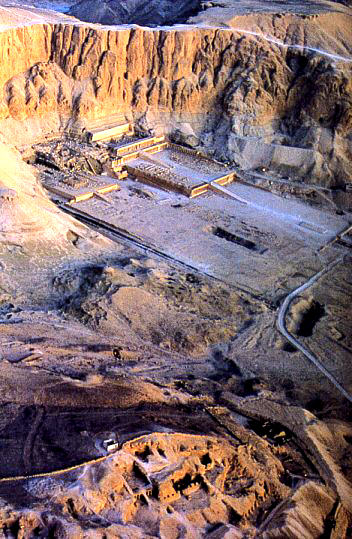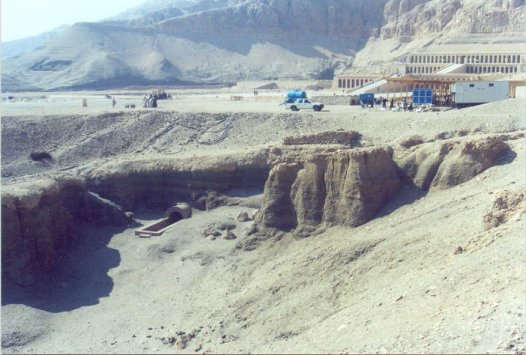 |
Senenmut |
last update:
26.03.2008
|
| |
TT71 and TT353
|
|
| Senenmut has built two memorial monuments for himself, TT71 and TT353. |

| The the ink-drawing above from his 2nd monument, TT353, shows the title "jmj-rA pr n Jmn
= Chief of the Domain of Amun" and his name. The sketch consists of the head and
shoulders of Senenmut, who faces toward the entrance. The sketch which has be
drawn with the help of a red grid of squares shows some correction of the neck.
The wig is separated into 6 horizontal sections each filled by wavy lines. The
sketch depicts a prosperous official as illustrated by full cheeks and a double
chin. |
| Influenced by findings during their discovery (see also the
single descriptions of TT71 and TT353) both monuments were interpreted as
independent tombs. The building of these monuments were thought to have begun
successively and should to reflect the "social" rise of their owner. |
| The monument, TT71, located at the very crest of "Sheikh Abd el-Qurna"
was thought to be probably a tomb that a high civil servant could afford. In contrast, the monument in Deir el-Bahari, TT353, directly beginning beside Djeser djeseru, has almost
"royal" extents.
This monument was thought reflects the development of his career.
|
| Therefore, both monuments are listed as Theban Tombs (= TT) 71
and 353. The following maps and photos should explain the location of TT71 and TT353. |

| Location of the two monuments built by Senenmut; please
note, the entrance of TT353 is located in the so-called
"Quarry of Senenmut (Steinbruch des Senenmut)"; both monuments
are presented on an own page. |

| Above the area "Sheikh Abd el-Qurna"
with the monument TT71 (red arrow), about 10 to 15 m below the top; this
picture was taken from the causeway to the temple of
Hatshepsut, Djeser djeseru; the blue arrow points to the (blue)
chapel of the Sheikh |

| Above an aerial photograph showing both "Sheikh Abd el-Qurna"
and the temple of Hatshepsut. The 2nd building below the summit of "Sheikh Abd
el-Qurna" is the the monument of Senenmut, TT71. |

| The "Quarry of Senenmut" with the modern
entrance to the monument TT353, in the background Djeser djeseru. Due to
security reasons TT353 is not accessible today. |
| During the last decades numerous doubts had been
raised concerning the acceptance that TT71 and TT353 are 2 separate
tombs which were built successively.
|
| First of all Dorman (1988) raised objections
against the dating of the ostracon of the year 16 and its allocations to the
start of construction work of TT353. Therefore, all dates tied up with this
ostracon are dubious - this applies also to temporal sequence of the start
of construction work on TT71 and TT353. Therefore, the terms 1st (older) tomb for TT71
and 2nd (later) tomb for TT353 are not correct. |
| Secondly, Dorman pointed out to the fact that
none of two monuments contains all necessary components of a typical Theban tomb.
|
| TT353 is entirely subterranean and has had no cult chapel.
|
| TT71 complies with the typical surface cult
chapel of Theban tombs of this time, however, unambiguously it has no coffin
chamber which fits to a tomb of this scale. The little coffin chamber in the
south-eastern corner of the transverse hall can only be considered to be
intended - at the very most - for a subsidiary burial.
|
| On closer examination both tombs complement each other, and
only together they could function as a typical private tomb. |
| Although the separation of tomb and cult chapel
has been a characteristic feature of royal tombs at the beginning of the
18th dynasty, it was not limited to the royal family, but appeared also with
private tombs - provided that the owners could "afford" it (e.g.
Maiherpri, Amenemope, Vizier User).
|
| However, it is puzzling, when and for what the
quartzite sarcophagus of Senenmut had been brought to TT71 on the hill
"Sheikh Abd el-Qurna" where it was finally shattered in pieces. Since TT71
had apparently no suitable burial chamber, the presence of the sarcophagus was absolutely
gratuitous.
|
| The possibility mentioned by Dorman, that the unfinished sarcophagus
has been [temporary] stored in TT71 because TT353 has not been finished yet, appears in view of the great effort
to drag the sarcophagus up the steep hill, only hardly conceivable.
An official who could afford such an imposing monument with a cult
chapel separated from the tomb had of course other possibilities to store a
sarcophagus.
|
| Maybe, so Dorman, TT71 served as a final
disposal site for a sarcophagus which was required no more and was therefore left unfinished,
because the intended user was no more available for the usual obsequies.
|
|




